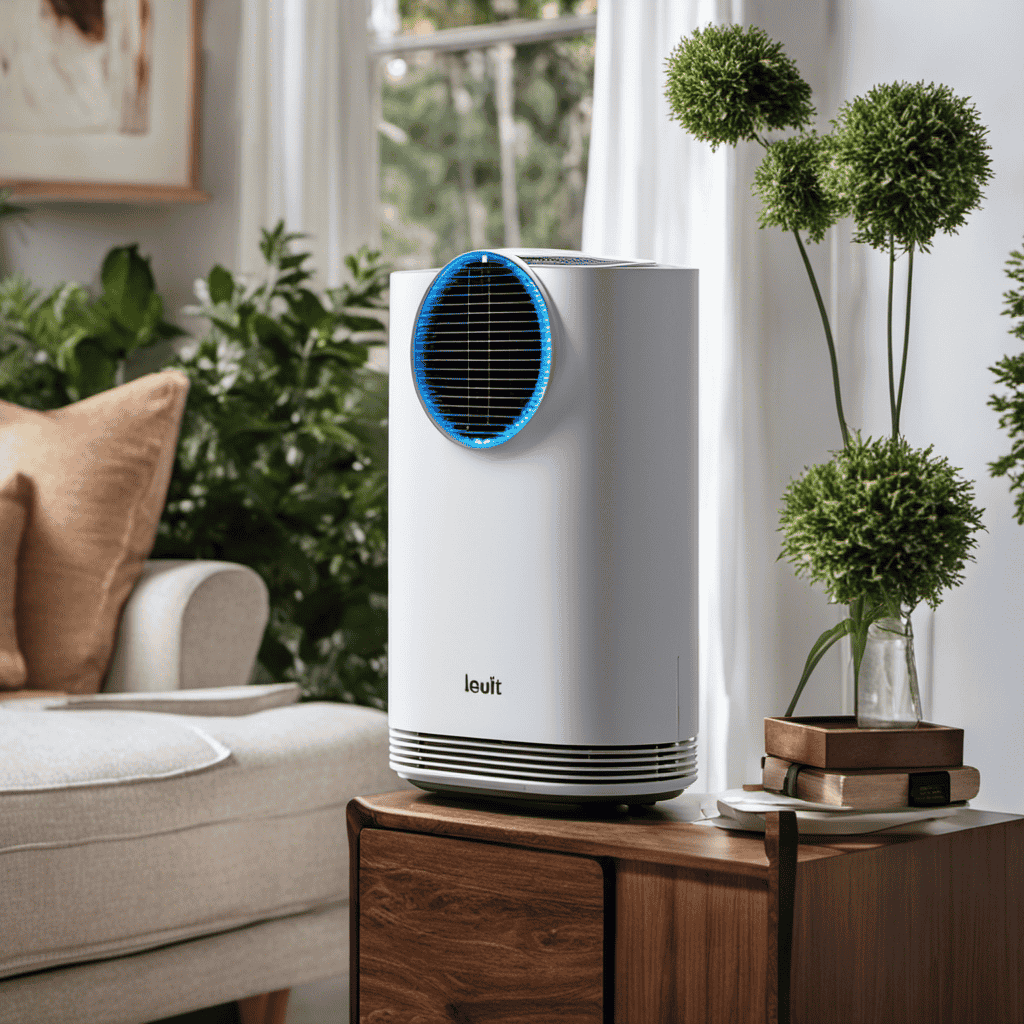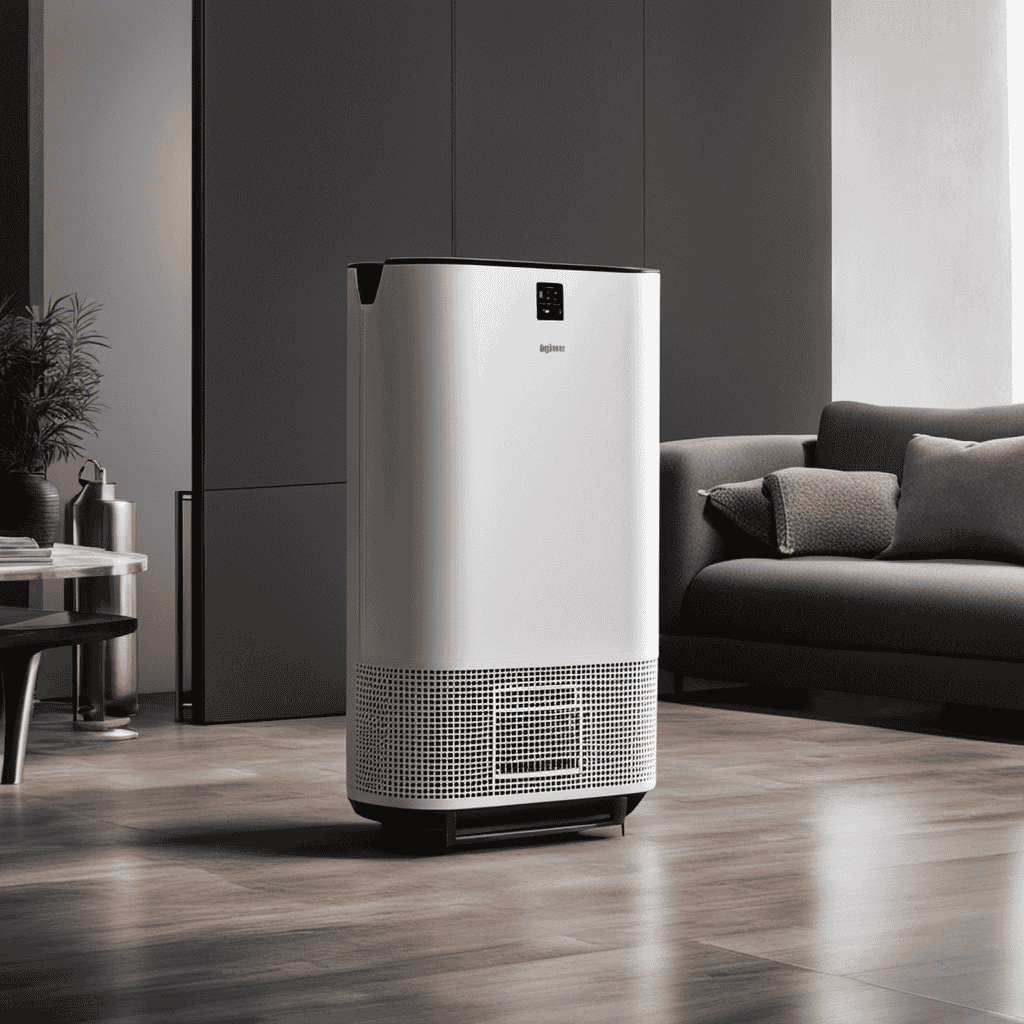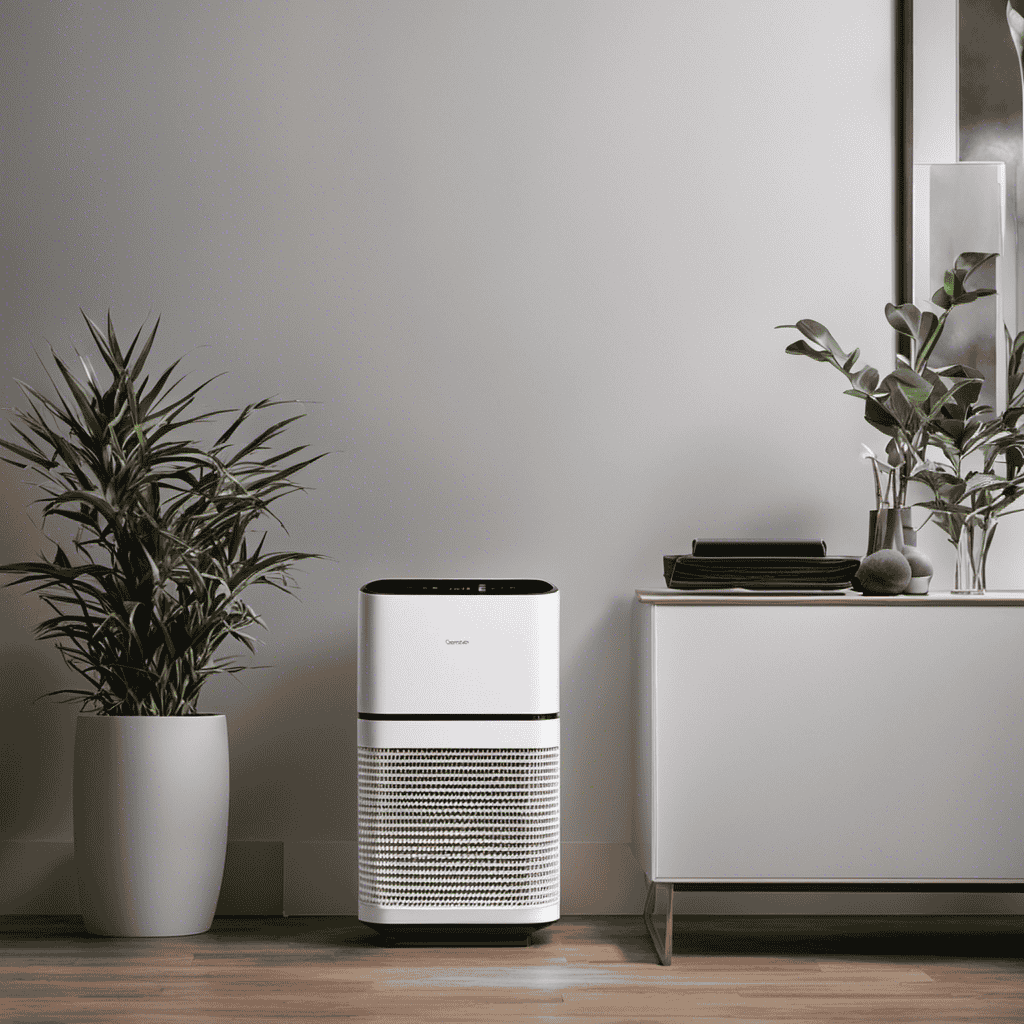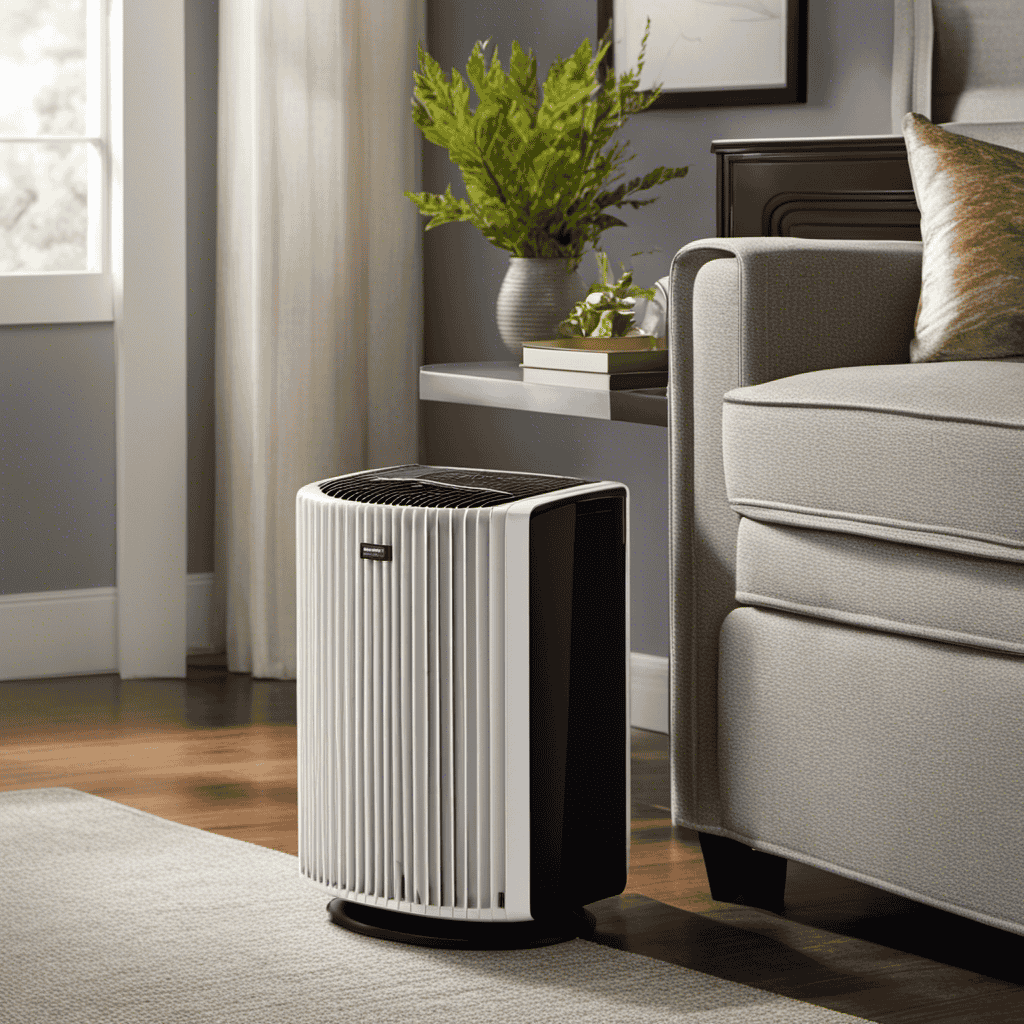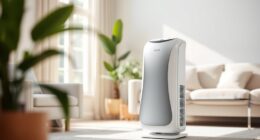I have always wondered about the functionality of the Levoit Air Purifier, which is why I decided to explore the scientific principles behind its operation.
In this article, I’ll explain the filtration process of the Levoit Air Purifier and explore its advanced features.
But that’s not all – I’ll also discuss how this remarkable device eliminates indoor air pollutants and its role in preventing allergies.
Lastly, I’ll share some tips on maintaining and cleaning the Levoit Air Purifier for optimal performance.
Let’s uncover the truth behind this innovative technology.
Key Takeaways
- Levoit air purifier uses a three-stage filtration system: pre-filter, True HEPA filter, and activated carbon filter.
- The True HEPA filter can capture particles as small as 0.3 microns, including dust, pollen, pet dander, mold spores, bacteria, and viruses.
- The activated carbon filter eliminates odors, smoke, and harmful gases.
- Regular maintenance, including filter replacement, is essential for optimal performance.
The Science Behind Levoit Air Purifier
The Levoit air purifier works by using a HEPA filter to trap and remove airborne particles. The technology behind the Levoit air purifier is based on the principle of high-efficiency particulate air (HEPA) filtration. HEPA filters are designed to capture particles as small as 0.3 microns in size, including dust, pollen, pet dander, mold spores, and even bacteria and viruses. This advanced filtration system ensures that the air in your home is free from these harmful particles.
Using a Levoit air purifier has many benefits. Firstly, it helps to improve indoor air quality by removing pollutants and allergens from the air. This is especially beneficial for people with allergies or respiratory conditions, as it can reduce symptoms and improve overall health. Secondly, the Levoit air purifier helps to eliminate unpleasant odors, such as those caused by cooking, pets, or smoke. It also helps to reduce the amount of dust and pet hair in your home, making it easier to keep clean.
Understanding the filtration process of the Levoit air purifier is crucial in order to fully grasp its effectiveness. By removing airborne particles through the HEPA filter, the Levoit air purifier ensures that the air you breathe is clean and healthy. This filtration process will be further explored in the subsequent section.
Understanding the Filtration Process of Levoit Air Purifier
To understand how it works, you’ll want to learn about the filtration process of the Levoit air purifier.
The Levoit air purifier utilizes a multi-stage filtration system to effectively remove airborne pollutants from the indoor environment. Here is a breakdown of the filtration process:
-
Pre-filter: The air first passes through a pre-filter, which captures large particles such as dust, pet hair, and lint. This helps to prolong the lifespan of the other filters.
-
True HEPA Filter: The next stage involves a True HEPA filter, which is designed to trap 99.97% of particles as small as 0.3 microns. This includes allergens, pollen, mold spores, and pet dander. The True HEPA filter ensures cleaner and healthier air.
-
Activated Carbon Filter: The activated carbon filter is responsible for eliminating odors, smoke, and harmful gases. It absorbs volatile organic compounds (VOCs), formaldehyde, and other chemicals, leaving the air smelling fresh and clean.
-
Benefits of using an air purifier: Using a Levoit air purifier has numerous benefits, such as improving indoor air quality, reducing allergy symptoms, and removing harmful pollutants. It can also help to eliminate unpleasant odors and create a healthier living environment.
-
Air purifier maintenance: To ensure optimal performance, regular maintenance of the air purifier is essential. This includes replacing the filters as recommended by the manufacturer, cleaning the exterior, and keeping the air purifier in a well-ventilated area.
Exploring the Advanced Features of Levoit Air Purifier
Ready to discover the advanced features of your Levoit air purifier? Levoit air purifiers are equipped with innovative technology that ensures clean and healthy air in your home. These advanced features bring numerous benefits, making them a must-have for every household.
One of the key features of Levoit air purifiers is their three-stage filtration system. This system includes a pre-filter, a True HEPA filter, and an activated carbon filter. The pre-filter captures large particles like dust and pet hair, while the True HEPA filter removes 99.97% of airborne pollutants as small as 0.3 microns, such as pollen, mold spores, and bacteria. The activated carbon filter then eliminates odors, smoke, and harmful chemical fumes.
Another innovative feature of Levoit air purifiers is the air quality sensor. This sensor constantly monitors the air quality in your home and adjusts the fan speed accordingly. When the air quality is poor, the purifier automatically increases the fan speed to quickly purify the air. This ensures that you always breathe in clean and fresh air.
Furthermore, Levoit air purifiers come with a sleep mode feature. This feature reduces the fan speed and noise level, allowing you to enjoy a quiet and undisturbed sleep while still benefiting from the purifier’s filtration system.
How Levoit Air Purifier Eliminates Indoor Air Pollutants
Curious about how your Levoit air purifier eliminates indoor air pollutants? Let me break it down for you. Here’s how it works:
-
Pre-Filter: The air purifier first captures large particles like dust, pet hair, and lint with a pre-filter. This helps prolong the life of the main filter and improves its efficiency.
-
True HEPA Filter: The Levoit air purifier is equipped with a True HEPA filter. This highly effective filter can remove up to 99.97% of airborne contaminants as small as 0.3 microns, such as pollen, mold spores, and pet dander.
-
Activated Carbon Filter: The activated carbon filter in the air purifier absorbs and traps odors, volatile organic compounds (VOCs), and harmful gases, leaving your indoor air smelling fresh and clean.
Regular air purifier maintenance is crucial to ensure optimal performance and longevity. Replace the filters as recommended by the manufacturer, typically every 6-12 months, depending on usage and air quality. Vacuuming the pre-filter regularly can also help maintain its effectiveness.
By eliminating indoor air pollutants, the Levoit air purifier offers numerous benefits. It helps improve indoor air quality, reduces allergy symptoms, and creates a healthier living environment. Additionally, it can alleviate asthma triggers and eliminate harmful particles that can cause respiratory illnesses.
Understanding how the Levoit air purifier eliminates indoor air pollutants is important, but it’s also essential to recognize its role in preventing allergies. Let’s delve into how this remarkable device can help keep allergies at bay.
The Role of Levoit Air Purifier in Allergy Prevention
If you suffer from allergies, the Levoit air purifier can be a game-changer for you. Allergies are triggered by various indoor allergens such as dust mites, pet dander, pollen, and mold spores. These allergens can cause symptoms like sneezing, coughing, itchy eyes, and congestion. The Levoit air purifier effectively combats these allergens to provide allergy prevention benefits.
The effectiveness of the Levoit air purifier lies in its advanced filtration system. It uses a three-stage filtration process to capture and eliminate allergens from the air. The pre-filter traps larger particles like dust and pet hair, while the True HEPA filter captures 99.97% of airborne particles as small as 0.3 microns, including pollen, mold spores, and pet dander. The activated carbon filter then absorbs odors and volatile organic compounds (VOCs).
In addition to its filtration system, the Levoit air purifier also features a high Clean Air Delivery Rate (CADR), which measures its efficiency in removing airborne pollutants. With a CADR rating of 135+ CFM, it can effectively clean the air in rooms up to 322 square feet, providing you with clean and fresh air.
Numerous studies have demonstrated the effectiveness of air purifiers in reducing allergy symptoms. A study published in the Journal of Allergy and Clinical Immunology found that using an air purifier with a HEPA filter significantly reduced airborne allergens and improved allergy symptoms in participants.
Overall, the Levoit air purifier is a reliable and effective solution for allergy prevention. Its advanced filtration system and high CADR rating make it a powerful tool in reducing allergens and improving indoor air quality. By investing in a Levoit air purifier, you can create a healthier and more comfortable environment, free from the triggers that cause your allergies to flare up.
Maintaining and Cleaning Your Levoit Air Purifier for Optimal Performance
When it comes to maintaining and cleaning my Levoit Air Purifier for optimal performance, there are several key points I need to keep in mind.
First and foremost is the filter replacement frequency, as regularly changing the filters ensures that the purifier continues to effectively remove pollutants from the air.
Secondly, I need to adhere to proper cleaning techniques to prevent any buildup of dust or debris that could hinder the purifier’s performance.
Lastly, troubleshooting common issues is crucial in order to address any potential problems that may arise and ensure that my Levoit Air Purifier continues to function at its best.
Filter Replacement Frequency
To ensure optimal performance, you should regularly replace the filters in your Levoit air purifier. The lifespan of the filters depends on several factors, including the air quality in your environment and the usage of the purifier. However, on average, it is recommended to replace the filters every 6-8 months.
Here are some important points to consider regarding filter replacement frequency:
-
Filter lifespan: The filters in your Levoit air purifier have a specific lifespan, which is determined by the manufacturer. It is important to adhere to the recommended replacement schedule to maintain the purifier’s effectiveness.
-
Filter maintenance: Regular maintenance, such as cleaning the filters and removing any accumulated dust or debris, can help extend their lifespan. However, it is important to note that cleaning alone is not sufficient, and replacement is still necessary.
-
Signs of filter deterioration: If you notice a decrease in air purification efficiency, increased noise, or a change in the filter’s color, it may be time to replace the filters.
Proper Cleaning Techniques
To keep your Levoit air purifier in top condition, regularly clean the filters using gentle techniques. Proper cleaning techniques are crucial to maintain the efficiency and longevity of your air purifier. Here are some maintenance tips to help you clean your Levoit air purifier effectively:
| Cleaning Technique | Frequency | Steps |
|---|---|---|
| Vacuuming | Every 2 weeks | 1. Turn off the air purifier and unplug it |
| 2. Use a vacuum cleaner with a brush | ||
| 3. Gently vacuum the exterior and filters | ||
| Washing | Every 3 months | 1. Remove the filters from the purifier |
| 2. Rinse the filters with water | ||
| 3. Let them air dry before reinserting | ||
| Dusting | Weekly | 1. Use a soft, dry cloth to wipe the unit |
| 2. Pay attention to vents and grilles |
Troubleshooting Common Issues
If you’re experiencing any issues with your Levoit air purifier, try troubleshooting common problems to resolve them quickly. Here are some troubleshooting tips for air purifiers:
-
Power Issues:
-
Check if the power cord is securely plugged into a working outlet.
-
Ensure that the power switch is turned on.
-
Try resetting the air purifier by unplugging it for a few minutes and then plugging it back in.
-
Poor Air Flow:
-
Clean or replace the air filters as instructed in the user manual.
-
Check if there are any obstructions blocking the air intake or outlet vents.
-
Ensure that the air purifier is placed in an area with proper ventilation.
-
Strange Odors:
-
Clean the pre-filter and activated carbon filter regularly to eliminate trapped odors.
-
Avoid using air fresheners or strong-smelling cleaning products near the air purifier.
-
Allow the air purifier to run for a few hours to circulate fresh air and remove any lingering odors.
Frequently Asked Questions
What Is the Warranty Period for the Levoit Air Purifier?
The warranty period for the Levoit Air Purifier is important to consider when purchasing this product. It provides coverage for a specific timeframe, ensuring that any potential issues or defects are addressed and resolved.
The warranty period for the Levoit Air Purifier varies depending on the specific model and the retailer from which it is purchased. It is recommended to review the warranty details provided by Levoit or the authorized retailer to understand the coverage and duration of the warranty period.
Can the Levoit Air Purifier Be Used in Large Rooms or Open Floor Plans?
The Levoit Air Purifier is highly effective in large rooms and open floor plans. It can clean the air in spaces up to 538 square feet, removing 99.97% of airborne particles as small as 0.3 microns.
The pros of the Levoit Air Purifier include its three-stage filtration system, quiet operation, and energy-efficient design.
However, some cons to consider are the need to replace filters regularly and the lack of an air quality sensor.
Does the Levoit Air Purifier Emit Any Harmful Ozone?
I can confirm that the Levoit Air Purifier does not emit any harmful ozone. This is a significant concern for many people, as ozone can have negative effects on our health.
The Levoit Air Purifier utilizes a highly efficient filtration system that effectively captures and removes allergens, such as pollen, dust, and pet dander. It is specifically designed to improve indoor air quality and provide relief for those with allergies.
How Often Should I Replace the Filters in My Levoit Air Purifier?
When it comes to replacing the filters in my Levoit Air Purifier, I follow a regular maintenance schedule. The recommended replacement frequency for the pre-filter is every 6 months. The True HEPA filter and activated carbon filter should be replaced every 12 months. This ensures optimal performance and efficiency.
To extend the lifespan of the filters, I vacuum them regularly and keep the air purifier in a clean environment. Following these maintenance tips keeps my air purifier working effectively.
Can the Levoit Air Purifier Help With Pet Odors and Dander?
Yes, the Levoit Air Purifier can definitely help with pet odors and dander. The performance of this air purifier is exceptional when it comes to eliminating unpleasant smells and reducing allergens caused by pets.
The benefits of using the Levoit Air Purifier include improved indoor air quality, reduced pet-related allergies, and a fresher smelling home. Its advanced filtration system efficiently captures pet dander and odors, providing a healthier and more comfortable living environment.
Can I Use the Same Method to Clean My Air Purifier as Levoit Air Purifier?
Yes, you can use the same method to clean your air purifier as Levoit Air Purifier. It’s important to understand the air purifier functionality explained in the user manual to effectively clean and maintain it. Regular maintenance ensures that your air purifier continues to work efficiently and effectively.
Conclusion
In conclusion, the Levoit Air Purifier is a remarkable device that combines cutting-edge technology and innovative design to provide a superior indoor air purification experience.
With its advanced filtration system and intelligent features, it efficiently eliminates various pollutants, allergens, and odors, ensuring a clean and healthy environment.
Its role in allergy prevention cannot be overstated, as it captures even the tiniest particles that can trigger allergic reactions.
By regularly maintaining and cleaning your Levoit Air Purifier, you can optimize its performance and enjoy the benefits of fresh, purified air throughout your home.
